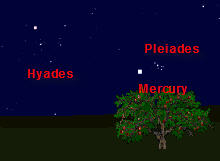| Volume 14 Issue 5 | May 2008 | |
| Planet Watch -- Keeping Track of the Visible Planets | ||
 Mercury becomes visible over west-northwest horizon
at sunset and each night for the first 2-3 weeks of the month it will set later
and thus be slightly higher at the same time each evening. From the 2nd-4th
Mercury will pass by the stars of the Pleiades (as shown in the image to the left),
and a few days later will pass the Hyades also.
Mercury becomes visible over west-northwest horizon
at sunset and each night for the first 2-3 weeks of the month it will set later
and thus be slightly higher at the same time each evening. From the 2nd-4th
Mercury will pass by the stars of the Pleiades (as shown in the image to the left),
and a few days later will pass the Hyades also.
Watch during this month as Mercury, and Elnath, the lower left corner of the pentagon-shaped Auriga, approach each other, but never meet. Venus lies just above the east-northeast horizon at sunrise and is very difficult to observe as it heads toward superior conjunction next month. Mars is moving steadily eastward and should provide plenty of celestial thrills as it speeds past Pollux and Castor early in the month,  and then passes across the stars of the Beehive Cluster in Cancer on the evenings
of the 21st through the 23rd.
and then passes across the stars of the Beehive Cluster in Cancer on the evenings
of the 21st through the 23rd.
This animated image shows Mars moving past the 'Twins' stars. It set for 1-day intervals and for about mid-evening local time. Keep watching Mars as it closes in on Saturn and Regulus later next month. Jupiter rises after midnight and continues to dominate the morning skies before sunrise as it shines brightly west of the handle of the teapot-shaped Sagittarius. Saturn is high over the west southwest horizon at sunset and will set around midnight local time. On the 3rd Saturn ends retrograde motion and resumes direct, or eastward, motion. It will pass within about 2.5 degrees from Regulus in Leo. On the 22nd Saturn reaches the point in an outer planet's orbit known as east quadrature. |
||
| Click Here For More Planet Information |